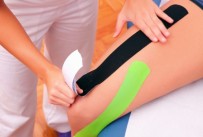Does Kinesiology Tape Work?

Does Kinesiology Tape Work?
Paul Kochoa, PT, DPT, OCS, CGFI
Recently, the New York Times answered a question in their Well column: Does kinesiology tape really work? Does it alleviate pain and injury while you exercise? And if so how does it work?
The general answer from the article is: No, “today’s science does not show that kinesiology tape is preferable in any way to plain athletic tape for the management or prevention of sports injuries.” But it does have a “robust placebo effect”.
The article references two studies that investigated the effectiveness of Kinesiotape and its placebo effect. There was no conclusive scientific evidence, even when analyzing several other studies, that Kinesiotape worked, and no conclusive answer on how it worked.
So what do we do now, should we still continue to use the tape? Sure. I use the tape. I use it a lot. Why? Because with this tape, there is no major adverse reactions to using it and for some cases it’s really effective.
Is it magic, or all in your head? No. There are so many different uses of the tape. (That may be its biggest advantage and its biggest disadvantage, but more on that later) We can stabilize a certain area or joint, but not to the point that it limits your range of motion or flexibility. We can use the tape to reduce swelling and bruising. We can facilitate or inhibit muscle contraction. We can even help mobilize and reduce scar tissue. So many uses with one type of tape. That may be part of the problem.
My opinion is that it works, but may not work for everyone. It all depends on why you’re using the tape. In my 10 years of using Kinesiotape, it really depends on correctly identifying the correct patient and your application technique. If you have a joint that really needs support, you may need a stiffer tape, like regular athletic tape or McConnell tape. If you need a little support or proprioceptive feedback, Kinesiotape will probably work for you.
Another problem is that there are so many different manufacturers of Kinesiotape (five, the last time I checked, and I’m not counting the foreign brands that you can’t get in the United States), and each one has their own way of application. Some brands are really good, and some are not so good. I have to say from my experience, the original brand that started it all pales in comparison to newer brands.
I’ve been a Certified Kinesiotape Practitioner, and with the ubiquity of Kinesiotape and YouTube, it’s really easy to think that anyone can apply the tape and be done with it. But it’s also easy to apply incorrectly and not feel anything. Without correct instruction, a good foundation of kinesiology, anatomy, and physiology; anyone can get the tape and try it out and conclude that it doesn’t work.
With so many different brands of Kinesiotape and different ways of applying it, you can see how scientifically evaluating its effectiveness and efficacy can be difficult.
Kinesiotape is just another adjunct to a good physical evaluation and skilled medical care. In the hands of a certified professional, it will probably be more effective than someone who just saw a video on how to use it.
Bottom line: Get someone who is knowledgeable and knows how to apply it. Use it. Give it a day or two. If it doesn’t work, take it off. Simple.
If you would like more information, please call Professional Physical Therapy and Training at 973-270-7417. Our offices are located within the YMCA locations in Madison and Summit, NJ. You do not need to be a member of the YMCA to visit us.
